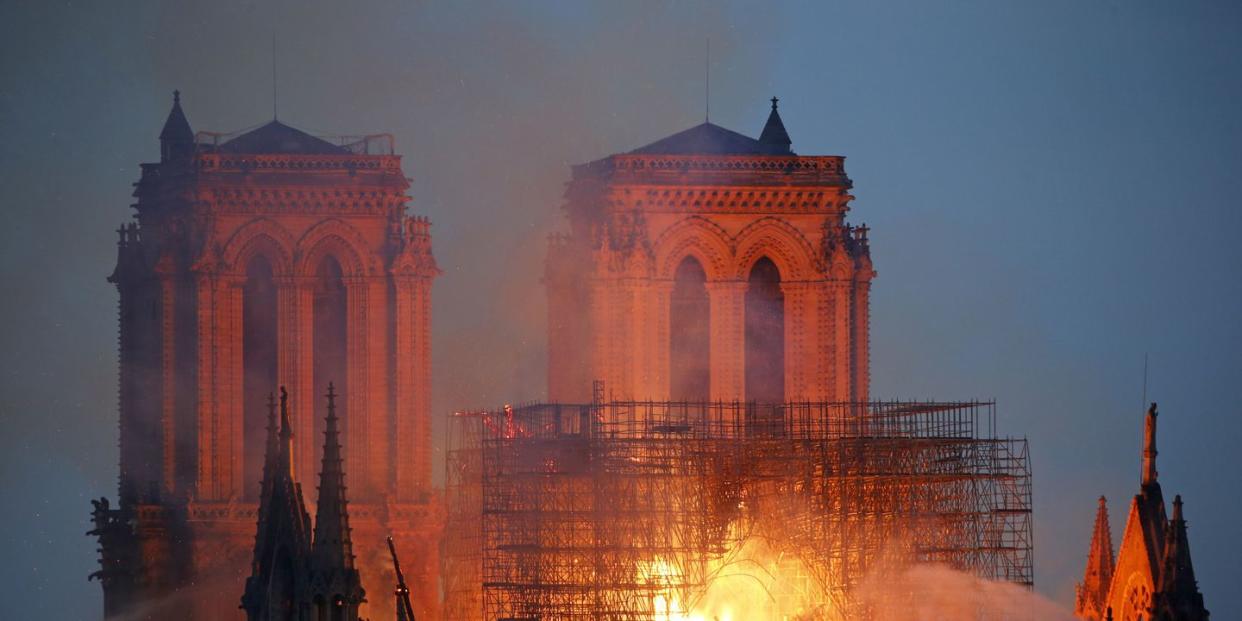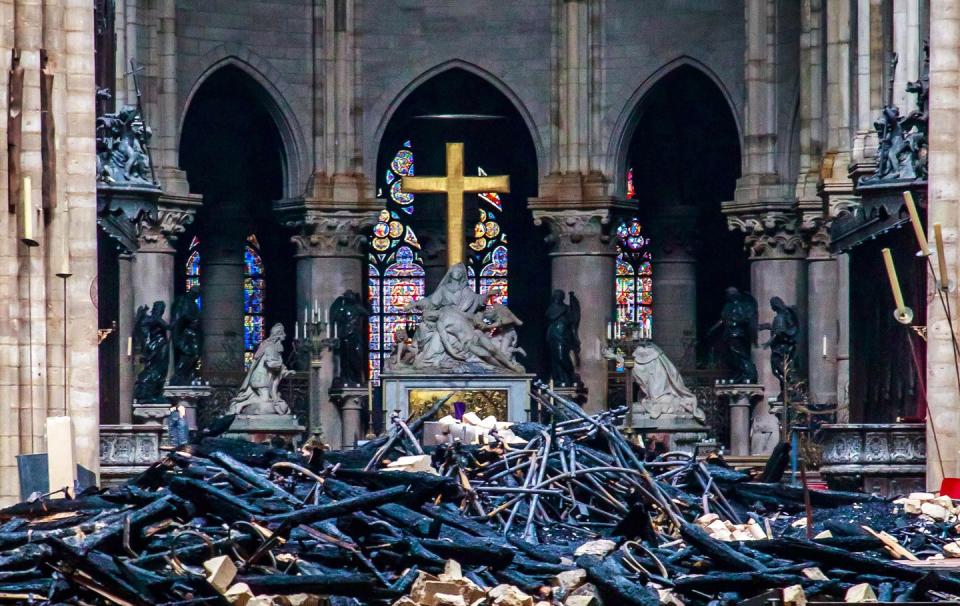Officials Think They've Figured Out the Cause of the Notre Dame Fire

There's a noticeable difference in Paris's skyline these days. The French city-along with architecture lovers the world over-mourned this April as the beloved Notre Dame cathedral caught fire, burning for nearly 8 hours. Bystanders watched in horror as the church's spire came crashing down, and the flames continued to blaze into the night. Now, with the fire out and the dust settled, the city faces the task of rebuilding; president Emmanuel Macron wasted no time in vowing to restore the iconic piece of Gothic architecture, and French business leaders like billionaires Francois Pinault and Bernard Arnault have already pledged funds for the task (100 million and 200 million Euros from Pinault and Arnault, respectively, to be exact). But what, exactly, will that take?

What caused the fire?
On June 26, Paris prosecutors revealed for the first time, two potential causes of the fire: a cigarette or an electrical malfunction. "Several hypotheses have caught the attention of the investigators including that of a malfunction of the electrical system or that of a fire caused by a poorly extinguished cigarette," said prosecutor Remy Heitz in a press release. This news comes after a two-month probe which involved interviewing over 100 witnesses and combing through some 1,200 clues.
"Even if certain failings, which may explain the scale of the fire, have been brought to light, the investigations carried out to date have not yet been able to determine the causes of the fire," says Heitz. The team did indicate that they have no reason to believe the fire was intentional.
What was built when?
To understand the extent of the fire's damage-and the necessary renovations-it's important to understand the history of the structure. Construction on the cathedral began in 1160 under France's Bishop Maurice de Sully, beginning with the church's choir and ambulatories, at the end of the structure close to the altar. Next came the high altar and the nave, followed by the bases of the church façade around 1190. The mid-1200s saw the completion of transepts, vaults, the beloved rose stained-glass windows, and, finally, the iconic flying buttresses.
Though by the late 13th century the cathedral would have looked largely recognizable to the modern eye, changes continued throughout the next centuries; it saw extensive renovations under Louis XIV and Louis XV to conform to the styles of their days. By the early 1800s, after the French Revolution saw the cathedral plundered and even some of its statues beheaded, Napoleon Bonaparte signed an agreement to restore the structure, but it soon fell into disrepair again. After Victor Hugo's The Hunchback of Notre Dame put the cathedral in the spotlight, King Louis Philippe ordered another restoration, which was overseen by Eugène-Emmanuel Viollet-le-Duc, an architect and restoration expert who also rebuilt parts of the Basilica of Saint Denis, Mont Saint-Michel, and Sainte-Chapelle following the Revolution.
Has Notre Dame been damaged before?
Yes-many times. In the 1500s, Hugenots destroyed parts of the cathedral in protest; the cathedral's original spire was damaged by wind and removed in the 18th century, then replaced (with the one that toppled yesterday) by Viollet-le-Duc in the 19th century; the French Revolution left severe damage, and World War II saw the structure battered by gunfire.
In more recent years, the cathedral's façade has suffered serious stains and deterioration from air pollution throughout the 19th and 20th centuries. The 800-year-old structure requires near-constant upkeep and frequent renovations, like the one that was taking place when the fire caught yesterday.
A post shared by The Met (@metmuseum) on Apr 15, 2019 at 12:17pm PDT
What was lost?
Sadly, in addition to the 19th-century spire, nearly all of the cathedral's 12th- and 13th-century oak frame has burned, according to CNN. That frame contained wood hewn as long ago as 1160-some of the oldest in Paris.
"To me, the most substantial loss was the frame, which was called 'the forest,' as it took one to build it," says Valentin Goux, president of French design company Rinck and an active member if the Institute of Classical Architecture & Art. "To think of the amazing work of the medieval carpenters gone, once and for all, is heart breaking."

At the time of construction, workers harvested an estimated 51 acres of wood, a feat that, sadly, won't be possible today. "We don't, at the moment, have trees on our territory of the size that were cut in the 13th century," Bertrand de Feydeau, vice president of preservation group Fondation du Patrimoine, told the Associated Press.
Thankfully, as the New York Times reported this morning, the building remains "structurally sound." Recent photos show the interiors, as well as the iconic bell towers, fairly intact. Also okay: the three 13th-century stained glass windows, the archbishop of Paris told a CNN affiliate there this morning, as well as the church's 8,000-pipe organ and several statues that had been removed for the renovation.
How should renovations look?
There is no question that the structure will be rebuilt. As President Macron said while speaking to a crowd of reporters last night, "more than 800 years ago, we were able to build it, and over the centuries make it grow and improve, so I solemnly say to you this evening: This cathedral, we will rebuild it, all together."
Of course, changes in technology and materials (like the wood shortage) make it impossible to truly build the structure just how it was. But how close should it come? On social media, critics and architecture enthusiasts have already taken to debating how the renovations should look.
"We are now faced with the epic questions that relentless challenge preservation and renovation authorities," noted one commenter on a photo posted on Instagram by the British artist Jonathan Myles-Lea that sparked many opinions. "Does restoring it to exactly what it was before capture the authenticity of its history? And will it totally erase the reality of the fire? Should the French embrace the opportunity to make a statement about themselves in 2019 as they rebuild?"
Commenters debated: "Paris ought to not turn it into a 'progressive' pseudo-modern zeitgeist-driven glass bunker, but rather celebrate true craftsmanship worthy of its creators," wrote one. "Worthy of their craftsmanship...worthy of its historical lesson to us and those after us."

Suggested Spencer Gervasoni, a member of the Young Member's Task Force of the ICAA and staunch supporter of a more strict renovation, "To prove in 2019 that we are even capable of creating what was made in the 13th century would be more a revelation than any 'authentic' contemporary gesture. As an aspiring architectural historian, I hope that we keep the hubris of 'making our mark' in check."
"We don’t want to see a terrible, cheap fake copy of it," agrees Goux. "This is very important, as so many places in the world were very poorly rebuilt. The best artisans must be used, and the best landmark architects. Only they will know how to bring back its glory to our Cathedral, the very heart of France."
In the weeks following the fire, artists and designers around the world presented plans for spire replacements ranging from a beam of light to a sculptural ornament of shimmering metal. On May 27, the French senate delivered a sound message on its opinion of such ideas: The new spire, they said, must be built as close to the original as possible.
Despite an open letter posted last month in French newspaper Le Figaro, in which 1,600 curators and preservationists warned against rushing the reconstruction, the senate's decision also included a clause that the project be complete by 2024-to be ready in time for Paris to host the Olympics.
What will Notre Dame's repairs entail?
Immediately following the fire, President Macron announced a national campaign to raise funds for the restoration, and, thanks to Notre Dame's global recognition, groups worldwide have taken up the cause-GoFundMe already has 50 Notre Dame fundraisers.
Of course, donations may well hinge on the eventual plans for the renovation's style: "I think the challenge will be whether or not people who give the money agree with those who are doing the rebuilding about how the cathedral should be rebuilt," said Lisa Bitel, a professor of religion and history at the University of Southern California told Reuters.

France is likely to enlist its most skilled craftsmen in the task. "Fortunately, this savoir faire is well preserved in France through 'les compagnons,' which are direct heirs to the cathedral builders," Goux says. "And we have amazing companies like Asselin, for example, who were good enough to rebuild Lafayette's Hermione a few years back. This kind of job is really their specialty." (In 2014, Asselin created a replica of the 32-gun ship, which carried the French General to the United States in 1780.)
Business Insider pointed out that, should the city elect to replicate the original, it might look, too, to "an unlikely source:" the video game Assassin's Creed Unity, which features the structure prominently; artist Caroline Miousse spent two years studying the cathedral to render it in the game.
Such varied touchpoints-in addition to the outpouring of tributes and the quick financial support-prove Notre Dame's status as a near universally revered landmark. In that way, it's lucky; unlike many lesser-known (though arguably equally magnificent) structures destroyed by warfare or natural disaster, there's little doubt that it will be restored.
"After this inconceivable episode, there will be gargantuan challenges, but there may yet be some things to look forward to," suggests Gervasoni. "This is undoubtedly the largest-ever global discourse about historic preservation and architectural tradition. And what will follow will not be easy. The restoration and rebuilding of Notre Dame might have precedent in physical scale, but not in cultural scale. Accordingly, it will ignite impassioned debates older than the smoldering timbers themselves about beauty, authenticity, and morality in the things we build."
Now, on to the task of ensuring its next 850 years.
Note: This story was originally posted on May 29, 2019. It has since been updated as we've learned more about the fire and the rebuilding efforts.
Follow House Beautiful on Instagram.
('You Might Also Like',)


